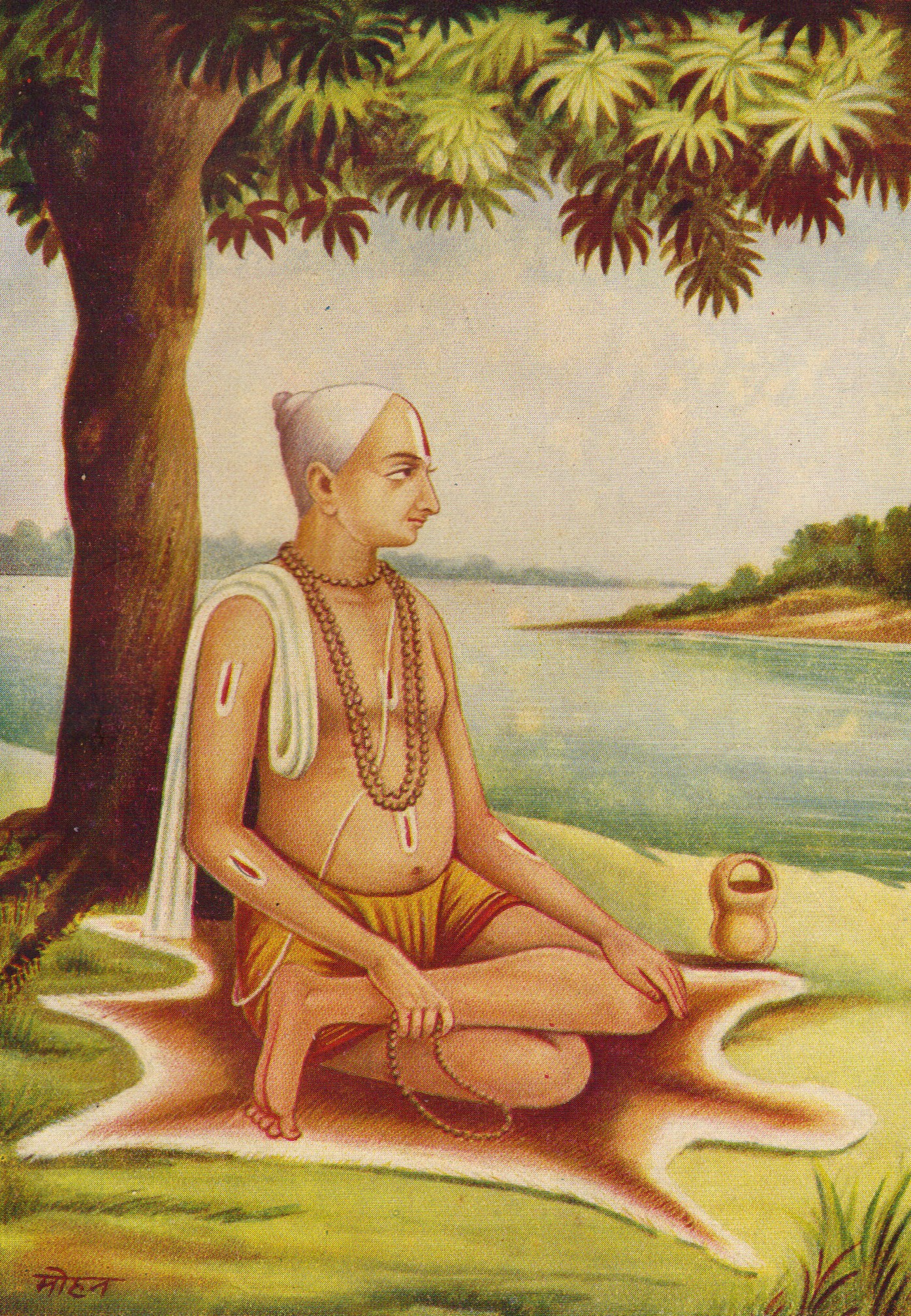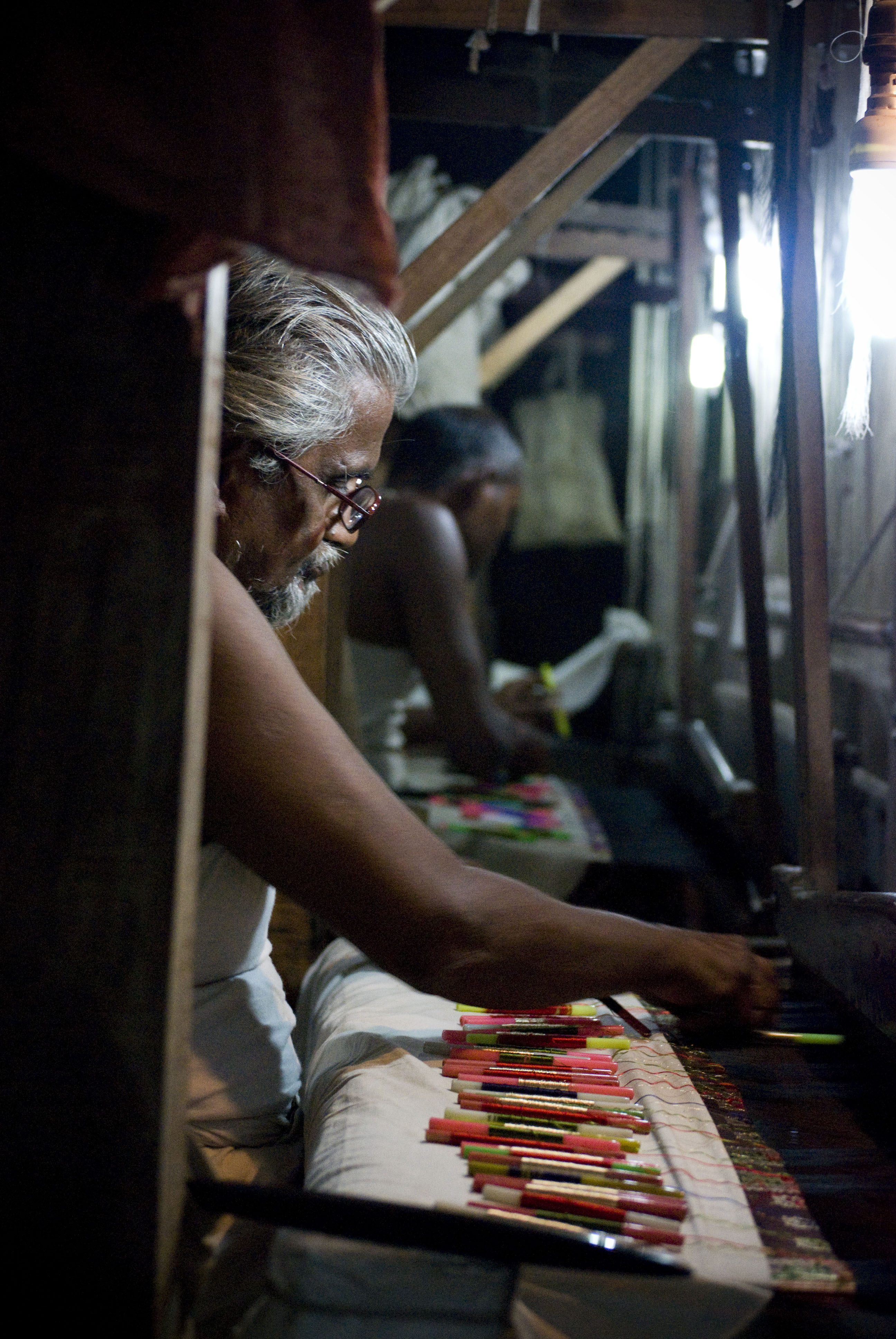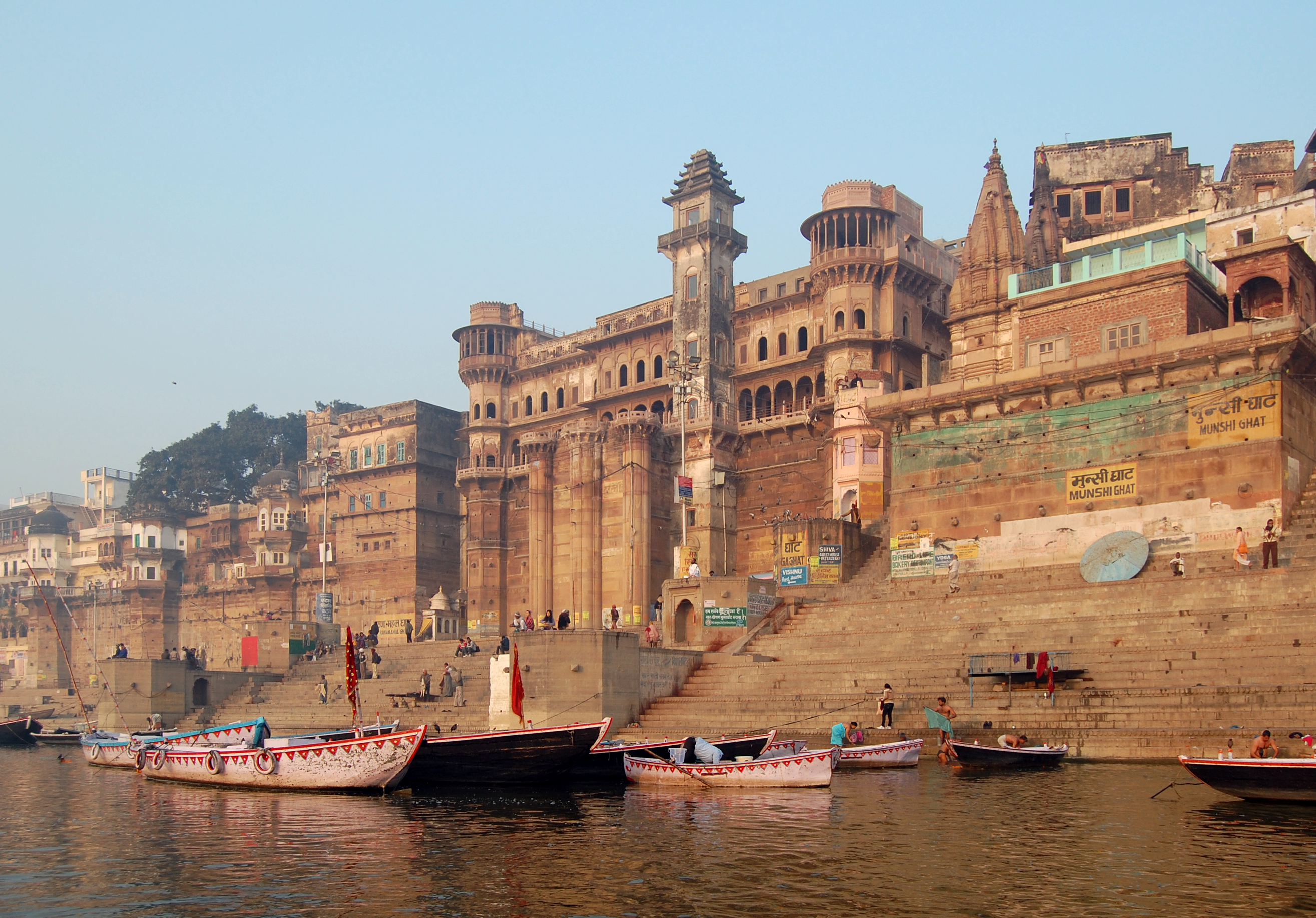
Back Benares Afrikaans فاراناسي Arabic مدينه فاراناسى ARZ Benarés AST वाराणसी AWA Bənarəs Azerbaijani بنارس AZB Варанасі Byelorussian Варанаси Bulgarian बनारस Bihari
An Varanasi (Vārāṇasī; Hindi: [ʋaːˈraːɳəsi]; siring man Benares, Banaras (Banāras Plantilya:IPA-hns;)[12][13][14] or Kashi (Kāshi; Plantilya:IPA-hns)[15]) iyo an syudad sa Ganges river sa Amihanan na Indya na igwa nin central place sa tradisyon kan pilgrimage, kagadanan, asin pagluksa sa kinaban kan mga Hindu.[16][17] An syudad igwa nin syncretic tradition kan Muslim artisanship that underpins an saiyang relihiyosong turismo.[18] Namomogtak sa middle-Ganges valley sa habagatan-subangan na kabtang kan estado kan Uttar Pradesh, an Varanasi namomogtak sa walang tampi kan salog. Iyan igwa nin 692 kilometres (430 mi) sa habagatan-subangan kan kabisera kan Indya na New Delhi asin 320 kilometres (200 mi) sa habagatan-subangan kan kabisera kan estado na Lucknow.
- ↑ Error sa pag-cite: Imbalidong
<ref>tatak; mayong teksto na ipinagtao para sa reperensiya na pinagngaranan naurban - ↑ Dikshit, Rajeev (13 May 2023). "In Varanasi BJP's Ashok Tiwari defeats SP by 1.33L votes". The Times of India. https://timesofindia.indiatimes.com/city/varanasi/in-varanasi-bjps-ashok-tiwari-defeats-sp-by-1-33l-votes-to-become-new-mayor/articleshow/100216621.cms. Retrieved on 21 May 2023.
- ↑ "Varanasi City". 7 January 2022. Archived from the original on 19 August 2021. Retrieved 21 November 2020. Unknown parameter
|url-status=ignored (help) - ↑ "District Census Handbook Varanasi" (PDF). censusindia.gov.in. Archived from the original (PDF) on 25 November 2020. Retrieved 23 December 2020. Unknown parameter
|url-status=ignored (help) - ↑ "Urban Agglomerations/Cities having population 1 lakh and above" (PDF). Office of the Registrar General & Census Commissioner, India. Archived from the original (PDF) on 17 October 2013. Retrieved 12 May 2014. Unknown parameter
|url-status=ignored (help) - ↑ 6.0 6.1 "52nd Report of the Commissioner for Linguistic Minorities in India" (PDF). nclm.nic.in. Ministry of Minority Affairs. Archived from the original (PDF) on 25 May 2017. Retrieved 26 December 2018. Unknown parameter
|url-status=ignored (help) - ↑ Western Standard Bhojpuri Archived 1 March 2014 at Archive.is Digital Library of Language Relationships (2012)
- ↑ "Yogi Adityanath is right. Route to UP's $1 trillion GDP goal passes through hinterland". Retrieved 25 September 2019.[permanent dead link]
- ↑ "Executive Summary" (PDF). Archived from the original (PDF) on 19 August 2019. Retrieved 29 December 2019. Unknown parameter
|url-status=ignored (help) - ↑ "Slum Free City Plan of Action Varanasi" (PDF). Archived from the original (PDF) on 28 June 2020. Retrieved 28 June 2020. Unknown parameter
|url-status=ignored (help) - ↑ Singh, Padam; Keshar, Satyendra (8 March 2016). "Development of Human Development Index at District Level for EAG States". Statistics and Applications 14 (1 & 2, 2016). https://ssca.org.in/media/4_2016_HDI_t1hcMZm.pdf. Retrieved on 4 March 2022.
- ↑ "Varanasi", Encyclopaedia Britannica, 1 September 2021, retrieved 14 December 2021,
Varanasi, also called Benares, Banaras, or Kashi, city, southeastern Uttar Pradesh state, northern India.
- ↑ San Chirico, Kerry P. C. (2012), "Banaras", in Juergensmeyer, Mark; Roof, Wade Clark, Encyclopedia of Global Religion, Volume 1, pp. 114–116, ISBN 9780761927297,
The city was identified in the Pali language as Baranasi, from which emerged the corrupt form of the name, "Banaras," by which the city is still widely known.
- ↑ "Benares" is the name that appears in the 1909 official map of India
- ↑ San Chirico, Kerry P. C. (2012), "Banaras", in Juergensmeyer, Mark; Roof, Wade Clark, Encyclopedia of Global Religion, Volume 1, pp. 114–116, ISBN 9780761927297,
... in the fifth century BCE, ..., the Kingdom of Kashi was one of the 16 kingdoms to emerge from the ascendant Aryan tribes.
- ↑ *Fouberg, Erin H.; Moseley, William G. (2018), Understanding World Geography, New York: John Wiley & Sons, p. 173, ISBN 9781119473169, OCLC 1066742384,
The city of Varanasi, India, is central to the death tradition in Hinduism. Hindus see Varanasi as the world of death and life, and some make pilgrimages to Varanasi to die. In Hindu tradition, if a person dies in the holy city of Varanasi on the Ganges River, he or she is attains moksha, or freedom from the cycle of death and rebirth. Pilgrims travel to Varanasi to cremate their deceased relatives on the ghats along the river.
- Eck, Diana (2013) [1981], Banaras, the City of Light, Alfred Knopf Inc, [Columbia University Press], p. 324,
–No other city on earth is as famous for death as is Banāras. More than for her temples and magnificent ghāts, more than for her silks and brocades, Banāras, the Great Cremation Ground, is known for death. At the center of the city along the riverfront is Manikarnikā, the sanctuary of death, with its ceaselessly smoking cremation pyres. The burning ghāt extends its influence and the sense of its presence throughout the city.
- Parry, Jonathan P. (2000) [1994], Death in Banaras, Lewis Henry Morgan Lectures, Cambridge University Press, p. 1, ISBN 9780521466257,
As a place to die, to dispose of the physical remains of the deceased and to perform the rites which ensure that the departest attains a 'good state' after death, the north Indian city of Banaras attracts pilgrims and mourners from all over the Hindu world.
- {{cite book | last = Singh | first = Ravi Nandan | title = Dead in Banaras: An Ethnography of Funeral Travelling | year = 2022 | publisher = Oxford University Press |location = Oxford, UK | isbn = |quote = The present-day Banaras, at first sign, is a new place. Rightly so, the baton must then pass on to an all new chronicling of the place. Yet, a connecting link, as always, may come into play, between the book's time and other times of Banaras. Let me give an example of what such a connection might look like. Jonathan Parry (1994) in his classic Death in Banaras laments in the preface to the book that he could not incorporate the coming in of the electric crematorium in his descriptions of the funerary organization in Banaras. Two decades later into my fieldwork, I found that it is in part, the efficiency of the open-air, manual cremation that Parry so effectively captures in his book that explains how a promising symbol of industrial modernity, the electric crematorium, falls short of the typecast. In the years between his book and my fieldwork, the electric crematorium sat lonely and was sparingly used against the cheer of the always-on, busy, manual pyres whose flames continue to dot the scene of the ghats in a contrasting relief. In this above sense, I believe, Parry already provides us a portrait of the electric crematorium's social imaginary in Banaras. The question of the shift from wooden pyres to the electric crematorium is then not about competing technologies but th
- Eck, Diana (2013) [1981], Banaras, the City of Light, Alfred Knopf Inc, [Columbia University Press], p. 324,
- ↑ Arnold, David (2021), Burning the Dead: Hindu Nationhood and the Global Construction of Indian Tradition, Oakland: University of California Press, p. 11, ISBN 9780520379343, LCCN 2020026923,
While Benares is undeniably central to the performance and perception of modern Indian cremation, that history cannot be told from Benares alone. Rather, ... the narrative needs to encompass colonial India’s two main metropolises, Bombay (Mumbai) and Calcutta (Kolkata), as well as the movement of Indians overseas and their memorialization abroad. ... The history of cremation in India is far more than the history of traditional rites and practices that it is conventionally taken to be—if tradition is assumed to mean “timeless” custom and immutable belief. On the contrary, cremation in modern India and across the South Asian diaspora is a history of contestation and change, of longing and denial, adaptation and innovation. India, too, has gifted to the world a modern cremation movement, though its meaning, form, and global resonance necessarily differed substantially from the Western cremation movement with which it was nearly contemporaneous.
- ↑ *Williams, Philippa (17 January 2019). "Working Narratives of Intercommunity Harmony in Varanasi's Silk Sari Industry". In Jeffrey, Roger; Jeffrey, Craig; Lerche, Jens. Development Failure and Identity Politics in Uttar Pradesh. SAGE. pp. 211–238. ISBN 978-81-321-1663-9.
'Varanasi … is the city where Hindus and Muslims … are interwoven like threads as in the lovely silk saris for which Kashi (Varanasi) is so famous for (Puniyani, 2006).'(quoted) Varanasi is most often represented as a sacred Hindu pilgrimage centre (see Eck, 1983), as its social and cultural urban spaces have been often examined through the imagined and lived realities of Hinduism (Hertel and Humes, 1993; Parry, 1994; Singh and Rana, 2002). But it is also home to a sizeable Muslim population, which in 2001 comprised 30 per cent of the city’s residents, significantly more than the percentage of Muslims in UP (Census of India, 2001). Unlike the city’s majority Hindu inhabitants (63 per cent), who occupy a range of occupations in different economic sectors, Muslims in the city are predominantly involved in the production of silk fabrics, as well as other smaller artisanal industries (see Kumar, 1988). Muslims first settled in Varanasi in the eleventh century, when, following the defeat of an invading Muslim army, women, children and civilians were permitted to remain on the northern side of the city and serve the Hindu kings. Many learned the craft of weaving, incorporating their skills and designs into the fabrics. Jean-Baptiste Tavernier, the French explorer and cultural anthropologist, visited Varanasi between 1660 and 1665 and reported that in the courtyard of a rest house in the Chowk area the trading of reshmi (silk) and suti (cotton) fabrics was taking place between Muslim karigars (artisans or craftsmen) and Hindu Mahajans (traders)
- Puniyani, Ram (21 April 2006), "Tackling Terrorism – Varanasi, Jama Masjid Show the Way", CounterCurrents.Org,
Varanasi, like many other cities of the country is the city where Hindus and Muslim of the city are interwoven like threads as in the lovely silk saris for which Kashi is so famous for. This town has hundreds and hundreds of Muslims artisans weaving the beautiful silk apparels, which are sold by the Hindu traders. This is also a city where on one hand we see the likes of Munshi Premchand, who wrote in Urdu as Nawab Rai and also crafted the acme of Hindi literature, which is not only progressive but is also a celebration of composite traditions of the country. This is also the city of the likes of Ustad Bismillah Khans, whose Shahanai begins with devotion to Hindu deities and hums the pleasant enchanting music into the ears of the whole nation. It is also the city which like most of the cities of the country, highlights the intercommunity amity in its most pleasant flavor.
- Mallet, Victor (2017). River of Life, River of Death: The Ganges and India's Future. Oxford, UK: Oxford University Press. ISBN 9780198786177. LCCN 2017939064.
Modi, however, went out of his way to court Varanasi’s Muslims—they account for nearly a quarter of the city’s 1.6 million voters—and to emphasize its multicultural, syncretic traditions when he was on the campaign trail in 2014. He praised not only Hindu but also Muslim cultural figures, including the musician Bismillah Khan, and said Khan was arguably the greatest symbol of Ganga-Jamuni tehzeeb (Ganga-Yamuna culture), a riverine phrase often used to describe the intertwined Hindu-Muslim culture of north India where those two rivers flow. Modi also targeted the important Muslim community of sari weavers in the district of Lallapura. Varanasi’s silk wedding saris, lavishly designed and interwoven with gold thread, are much sought after by Indians from across the country and from overseas, and Modi promised to help the weavers acquire modern technology, quality raw materials and better marketing skills so they could compete with Chinese clothing manufacturers. ‘The weavers of Varanasi are an integral part of the city’s history', he wrote in a blog post on his nomination day. ‘It is my resolve to ensure that they stand on their own feet with pride and their future generations have a bright future.’ (pp. 51–52) An earlier great poet, son of Varanasi and symbol of north India’s syncretic traditions, was the fifteenth-century Kabir, whose pithy lines in Hindi are still much quoted today by Indians over social media. Again, the legends surrounding his life are confused. He may have been born into a low-caste Muslim community of weavers or been a Hindu by birth. But he famously mocked the priesthoods and the rituals of both Muslims and Hindus, even to the extent of deliberately leaving holy Varanasi to die in an obscure town, when most north Indians would be heading in the other direction and yearning to expire within the boundaries of the city to find salvation. His contempt for organized religion is reflected in the legend of his death: Hindu and Muslim devotees argued over who should claim the poet’s remains, but when the cloth covering his body was lifted, they found nothing underneath but a spray of flowers. (pp 60–61)
- Kumar, Nita (2017) [1988], The Artisans of Banaras: Popular Culture and Identity, 1880–1986, Princeton Legacy Library, Princeton University Press, pp. 15, 18, 137, ISBN 9781400886999,
The simplicty of weavers' weddings is a contrast even to those of other Muslims, such as the Pathans. (p. 15) ... Contrary to the experience of most artisan production in modern times, the silk weaving industry has actually flourished, and remained the commercial backbone of the Hindu pilgrimage and religious centre of Banaras. (p. 18) The debate on how Muslims in other parts of South Asia adjust an "Islamic" identity with a territorial-cultural one which is heavily oriented towards local Hinduism is very instructive with regard to our material. The weaver of Banaras is as shaukeen a man as the Hindu and central to his life-style is the love of the outside, of akharas, and of music.(pp. 137–138)
- San Chirico, Kerry P. C. (2012), "Banaras", in Juergensmeyer, Mark; Roof, Wade Clark, Encyclopedia of Global Religion, Volume 1, pp. 114–116, ISBN 9780761927297,
This was the period in which an enduring cultural imprint was made in ... the establishment of muhallas or neighborhoods that exist to this day, in the presence of Sufi shrines dotting the landscape, and in the creation of a singular syncretic culture ... Today Islam accounts for more than one-third of Varanasi city's population. There are as many Muslims here as there are Brahmans, the majority of whom are weavers. The relationship between the Muslims who weave Banaras's famous saris and the Hindus who sell them explains in part by historically there has been less communal tension here than in other cities throughout South Asia.
- Puniyani, Ram (21 April 2006), "Tackling Terrorism – Varanasi, Jama Masjid Show the Way", CounterCurrents.Org,







